Sick leave has a huge effect on operational efficiency in the workplace, and yet it almost always comes as a surprise when we discover just how many days are lost to illness each year.
There are a few very good reasons why your employees may be taking more sick leave than you’d like – understanding these will help you put strategies in place that reduce the impact of sickness on your organization.
In this blog post, we’ll explain exactly what those reasons are and offer suggestions on how to cut down unnecessary employee absences from work. So, if you’re ready to learn how to reduce sick leave in the workplace and boost team productivity, keep reading!
Top 5 Reasons Why Employees Take Sick Leave
- Actual illness or disease: When your body decides to wage war against you and make you feel like you’ve been hit by a ten-ton truck, you have no other choice but to take a day or two (or ten) to recover – ain’t no shame in that game.
- Mental burnout: The constant pressure to perform well and the ever-increasing workloads can take a toll on even the hardiest of individuals. In fact, 77% of workers in a Deloitte survey reported feeling burnt out at least once in their current jobs. This means that over three-quarters of employees are at an increased risk of developing various burnout-related conditions, including insomnia, depression, and much more.
- Need to take care of a loved one: Whether it’s a child who is home sick from school or an elderly parent who requires assistance, taking care of a loved one is not just a valid reason to take a sick leave, it’s a human one. Because at the end of the day, people are not just employees or bosses or coworkers. We’re human beings with lives outside of the office, and sometimes family obligations take precedence over work.
- Personal emergency: Life happens, and just when we think we have everything under control, a curveball like a minor car accident or a major household catastrophe can come flying right at us. Whatever the case may be, it can be really hard to focus on anything else until the problem is resolved. And sometimes, you simply have to address it head-on and prioritize your well-being before returning to work and becoming your productive self again.
- Reluctance to work: Have you ever felt like you’d rather be anywhere but at work? It’s not the most pleasant of feelings, but many employees experience it once in a while. What’s important here is to recognize when such reluctance is not just a rare occurrence but a sign of a deeper issue that needs addressing – like the lack of motivation, workplace conflicts, and so on.
When Sick Leave Becomes a Problem
As you can see, employees call in sick not only when they’re actually sick. And while this may not be a problem when happens rarely, you must become very concerned if an occasional incident turns into a persistent trend.
When employees falsely take sick leave too often, your company may suffer from:
- Disrupted workflows within departments and the consequent delays in task and project completion.
- Undue burden on other team members who are already working at full capacity, reducing their morale and productivity levels.
- Lost revenue, as well as higher labor costs if temporary employees are hired to fill in the work gap.
To deal with the problem effectively, you need to follow a couple of rules:
Rule #1: Calculate the absenteeism rate
First of all, you should know how to calculate your staff’s absenteeism rate. Luckily, the formula itself is quite simple:
Absenteeism rate = (Number of absence days / Number of scheduled work days) x 100
Just determine the total number of days that employees were absent during a given period (let’s say a month). Next, calculate the total number of days that employees were scheduled to work during that same period. Finally, divide the number of absent days by the number of scheduled workdays and multiply by 100 to get the absenteeism rate as a %.
For instance, if you have an employee who was scheduled to work 22 days in a month but only showed up for 18 days, then their absenteeism rate would be (22-18) / 22 x 100 = 18.18%.
Rule #2: Evaluate it
Once the absenteeism rate is calculated, you need to evaluate it, considering a variety of factors, including:
- The specific job roles within your workplace,
- The nature of your business,
- Your workforce demographics,
- And, of course, the reasons why employees went absent.
Remember that it’s rather impossible to determine whether your staff’s absenteeism rate is high or low right off the bat because numbers don’t tell the whole story. For example, if there is a flu outbreak affecting your area, you may see a spike in absenteeism due to illness. Similarly, if your company has poor employee morale or lacks a good work-life balance, you may see higher absenteeism rates.
The goal here is to look into the numbers closely, compare them over time, and benchmark them against your industry standards.
Rule #3: Don’t be nosy
While it’s useful to know why staff members take sick leave, being too nosy can actually do more harm both to your employees and your business.
Mind the risk of violating a person’s privacy – after all some questions about one’s health condition are uncomfortable to answer. And in case you suspect that an employee abuses sick leave and is not very honest, simply ask for a sick note (aka fit note) from a healthcare practitioner – it should be enough to dispel your concerns.
Rule #4: Take measures to reduce absenteeism
Remember that calculating the absenteeism rate shouldn’t be the end goal but a starting point for identifying preventable root causes of unplanned absences and long-term employee sickness, such as burnout, low team morale, and even poor job satisfaction.
By addressing these issues, you can improve employee engagement and productivity, building a more successful and sustainable business. Here are a few tips to help you on the way:
5 Proven Tips on How to Reduce Sick Leave in the Workplace
1. Create a comprehensive sick leave policy
Creating a sick leave policy provides a structured approach for managing absenteeism. However, such a policy is much more than just laying out the number of sick days allowed – it explains the rights of employees when it comes to sickness absence and provides all the information regarding the sick leave management process.
Here are a few tips on how to create a proper sick leave policy:
- Start by assessing legal requirements in your country or state: Most nations have laws and regulations governing sick leaves, such as the number of days an employee can avail, the type of illnesses covered, and the procedure for reporting sick leave.
- Determine the number of sick days offered to your employees: The standard number of sick days each year ranges from five to ten. However, you can offer more or less depending on your employees’ needs.
- Clarify the details: Will unused sick days roll over each year? Can employees use sick days to care for family members? Is there a cap on the number of sick days an employee can take per year? These are all essential questions to consider when creating a comprehensive policy.
- Outline the process for requesting sick leave: Will employees need to provide a doctor’s note? How far in advance should sick days be requested? What happens if an employee doesn’t have any sick days but needs to take time off for an illness?
For more inspiration, feel free to check out this guide on how to create a proper PTO policy. 👈

2. Establish a simple sick leave management process
Having a streamlined system in place allows your employees to take sick leave without any unnecessary delays or red tape. This not only promotes a healthy work-life balance but also helps to minimize stress and burnout.
Moreover, a simple sick leave management process helps to mitigate the risk of sick leave abuse or misuse. Clear and simple procedures for leave requesting and verification let managers identify any potential fraudulent behavior more easily and take appropriate action if necessary.
actiPLANS is the ultimate solution for those who are tired of the old-fashioned, outdated way of sick leave management. To begin with, it makes requesting sick leave an absolute breeze for employees.
Simply log in to the system, select the dates you’ll be out of the office, and voila! Your request is submitted and ready for approval. Plus, you can add any notes or comments to let your manager or HR team know the reason for your absence and when you’ll return to work.
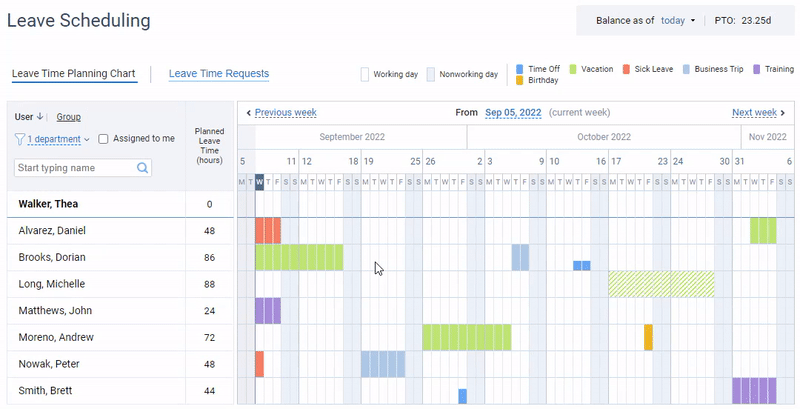
Schedule time off on a visual timeline
From the moment users’ leave requests are submitted, actiPLANS automatically updates their personal and shared schedules, letting everyone know when each team member goes absent and for how long.
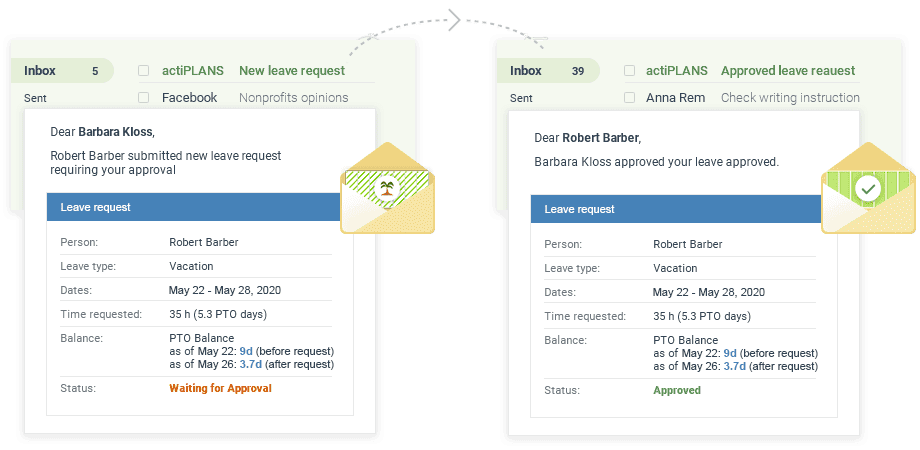
Receive email notifications on leave requests
On top of that, built-in automation speeds up the leave request approval process and makes time off accrual error-free. Besides, actiPLANS has a handy mobile app that enables you to request and track time off right on your smartphone, wherever you are – it doesn’t get any simpler than this!
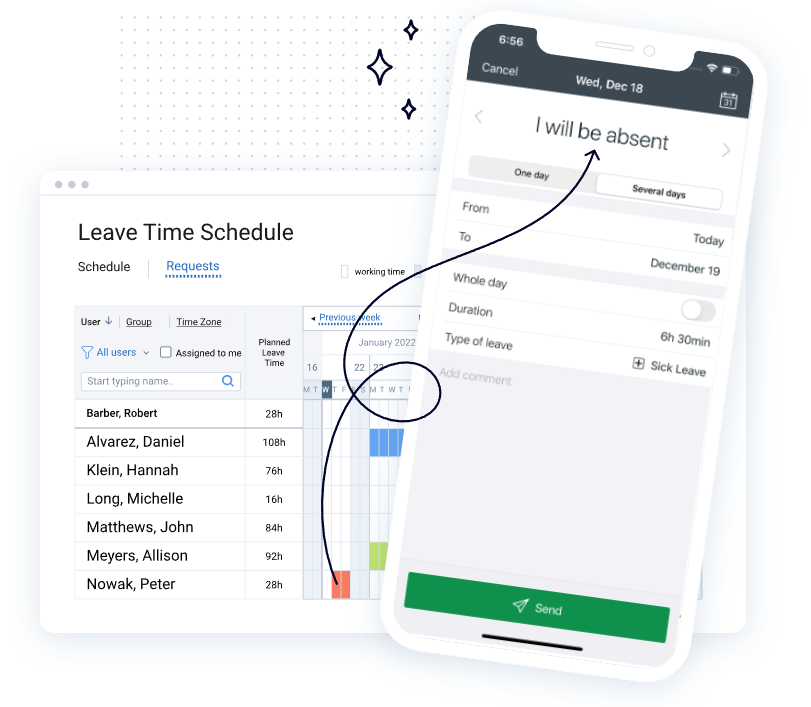
Track team absences and submit leave requests on your smartphone
Sign up for a free actiPLANS trial here. 👈
3. Offer diverse leave types
As an employer, offering diverse leave types is not only an ethical responsibility but a strategic move to attract and retain top talent.
Diverse leave types give team members greater flexibility and help to create a healthier work-life balance. They enable employers to promote employee well-being and help to create a more inclusive workplace, which ultimately increases employee satisfaction and productivity.
Besides, with more leave types in place, it becomes much easier to track the exact reasons why employees go absent and detect any problems early on.
Here are a few valuable leave types that can help you reduce sickness absence:
- Duvet day – It’s the equivalent of a sick day, but without the germs and tissues. It’s a sanctioned excuse to cocoon yourself in blankets, avoid human interaction, and indulge in some much-needed Netflix binges. It gives an employee’s mind and body the break they deserve, which serves to promote mental health.
- Bereavement leave – It is a paid or unpaid leave of absence granted to employees who have experienced the loss of a loved one. It provides employees with time to grieve, attend funeral services, and handle any necessary arrangements, without worrying about work obligations.
- Floating holiday – It’s a flexible day off that an employee can schedule for themselves according to their personal preferences or cultural/religious beliefs. It’s a great way for companies to show their appreciation for diversity and acknowledge the individual needs of their staff members, while still ensuring the continuity of business operations.
Explore the various leave types in greater depth here. 👈
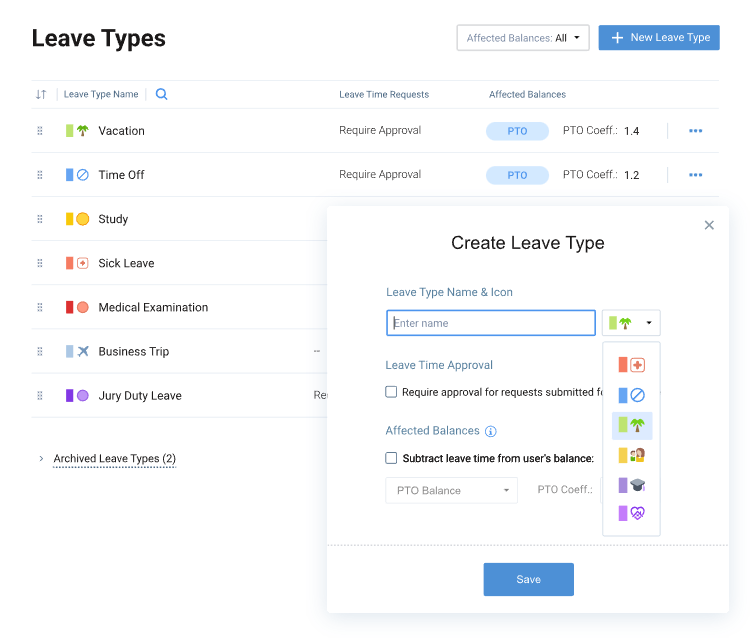
Create and track multiple custom leave types with actiPLANS
4. Foster a positive work environment
A positive work environment is an environment where employees are happy to be. In such a workplace, employee engagement, productivity, and satisfaction naturally increase. It also produces greater retention rates, lower absenteeism, and a more collaborative and innovative team dynamic (Source).
In short, when employees are happy, the company thrives. Here are just a few tips on how to achieve that:
- Offer competitive benefits: A positive work environment instills a sense of safety, which, in turn, can be promoted by a good benefits plan. Offering such perks as unlimited vacation time, fully paid family medical coverage, and monthly contributions to employee 401(k) plans are just some of the ways to keep your employees happy, healthy, and hungry for success.
- Develop wellness programs: This workplace initiative is specifically designed to promote a healthier and happier workforce. It typically includes such activities and services as fitness classes, mental health support, and healthy food options to help employees improve their physical and mental well-being while at work.
- Provide opportunities for bonding: In a world where we spend most of our day at work, it’s important to have a sense of belonging. Bonding with coworkers not only creates a supportive community but also has been proven to positively impact mental health by reducing stress and loneliness.
- Manage workloads wisely: Delegating tasks based on individual strengths, prioritize assignments, and set realistic deadlines to minimize the risk of burnout in employees. Be sure to apply a proper project management solution like actiTIME in order to simplify work allocation, estimate resources more accurately, and monitor performance progress in real time.
Explore how to deal with toxic work culture here. 👈
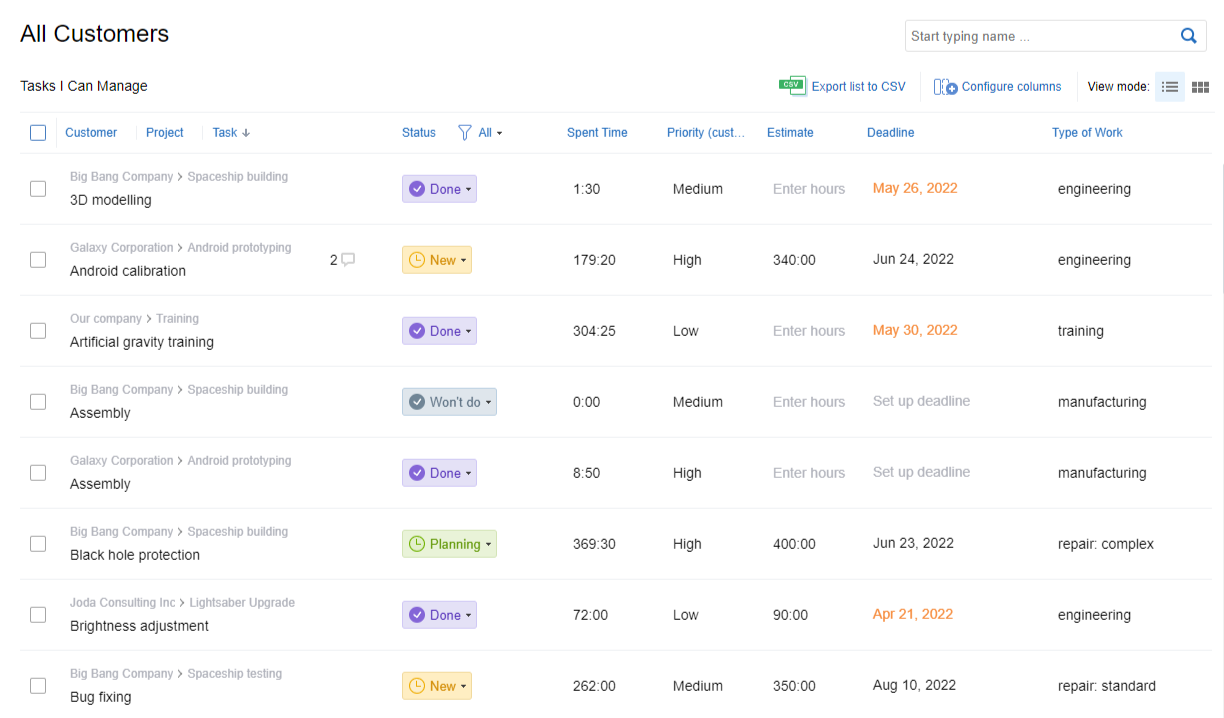
Manage team workloads and track work progress with actiTIME
5. Consider flexible work arrangements
Remote working, staggered work hours, compressed work weeks, and other flexible work arrangements can make a world of difference in terms of how employees feel.
When employees feel like they have more control over their work schedules, they are more likely to feel satisfied with their jobs and less likely to experience burnout. This can lead to increased productivity and better overall performance.
Besides, remote employees tend to be absent less frequently than office workers. This makes perfect sense knowing that their lives don’t run on a nine-to-five schedule.
For example, a parent attending an office may need to leave early to pick up their child from daycare, or a caregiver may need to rearrange their schedule to accommodate a doctor’s appointment. By providing employees with the flexibility to adjust their work schedules as they please, companies can reduce the stress and pressure that comes with trying to juggle work and personal obligations.
The low absence trend among remote employees has a downside, though, which should be taken into account – they are now less likely to take proper sick leave when they’re actually sick. This is bad for a business because such presenteeism is actually associated with lower employee productivity and poorer quality of work.
So, while offering flexibility to employees, make sure you discourage presenteeism and provide them with enough time to recover when they’re sick. Address this issue in your remote work policy and develop such a policy with workers’ well-being in mind.
Read our guide on absence management in remote teams here. 👈
Conclusion
It doesn’t take a medical degree to understand how important it is to reduce sick leave in the workplace – it’s not only the right thing to do for your team but also critically important for your business’s bottom line.
Employers need to find ways to proactively minimize absences, while providing a supportive environment that makes employees feel comfortable coming forward about their condition and, if appropriate, stay home and rest when they’re feeling ill.
Luckily, actiPLANS can help businesses track staff absences automatically and in real time, making it easier than ever for managers to keep tabs on both those taking time off due to illness, as well as any other unexpected employee absences.
You might be surprised at how much of a difference actiPLANS features can make when it comes to reducing sick leave and freeing up time and resources in your team. So, why not give it a try?




